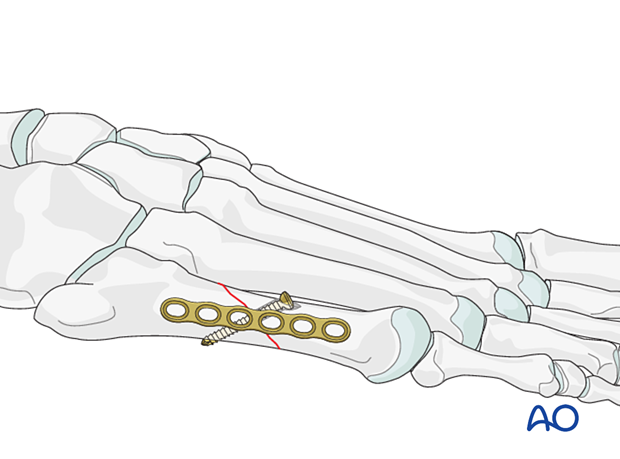Lag screw and neutralization plate
1. General considerations
Principles
A lag screw is used to compress and create absolute stability across the oblique fracture. As the lag screw is insufficient to maintain reduction over time, a neutralization plate is applied to protect the lag screw fixation.
The lag screw is inserted perpendicular to the fracture plane.

Anatomical considerations
Proper alignment of the metatarsal heads is a critical goal in restoring the forefoot mechanics.
A normal curved “cascade” (Lelièvre’s parabola) appearance, which is symmetric with the other foot, is mandatory on the AP view. See illustration. This symmetry ensures that the normal length of the metatarsal is restored.
It is also critical to restore the metatarsals in their axial or horizontal plane so that all the metatarsal heads are on the same level in the axial view.
Any malalignment, particularly flexion, will recreate focally high pressure during the stance phase and toe-off, resulting in pain and subsequent callus formation.
The sesamoids, rather than the first metatarsal head, bear weight in the first row. Therefore, one must look at the sesamoid level in establishing the alignment in the axial or horizontal plane of the first metatarsal.

Timing of surgery
The timing of surgery is influenced by the soft tissue injury and the patient's physiologic status.

2. Patient preparation
This procedure is typically performed with the patient placed supine with the knee flexed at 90°.

3. Approaches
The lateral approach to the fifth metatarsal can be used for this procedure.
Further approaches may be needed in the case several metatarsals are fractured.
4. Reduction and screw fixation
Reduce the oblique fracture and temporarily fix it using reduction forceps.
Forceps are applied perpendicular to the fracture.

Insert a lag screw perpendicular to the fracture plane.

For long oblique fractures, two screws may be used.
In long spiral fractures, several lag screws can often be inserted. Consequently, the screws are inserted in a spiral pattern.

5. Application of neutralization plate
Plate selection
Typically a 5–6 hole plate is used.
Usually, 2.4 or 2.7 mm plates are used. The size is based on the caliber of the bone.

Plate location
The plate should be placed in the metatarsal mid axis, either laterally or dorsally on the fifth metatarsal.

Plate contouring
The plate is contoured to fit the surface of the bone.

Plate application
Secure the plate using screws inserted in neutral mode.

6. Aftercare
An appropriate well-padded dressing should be applied to protect the surgical incision. Compression will help control swelling.
If present, the skin-pin interface should be similarly well-padded but with dressings that can be readily removed to inspect for pin site infection.
Immediate postoperative treatment is rest, ice, and elevation.
The patient should restrict weight-bearing for six weeks until signs of radiographic healing are present. After this, patients can be weight-bearing as tolerated.
Patients must exercise their ankle and subtalar joints out of the orthosis to prevent stiffness (eg, by stretching their Achilles).
X-ray the metatarsals at six weeks to confirm satisfactory union and remove K-wires if present. Once the fracture is united, the orthosis may be gradually discontinued.
A gastrocnemius release may need to be performed in cases with postoperative gastrocnemius contracture. This occurs more typically in the mid- and hindfoot.
If the gastrocnemius muscle has been released, a splint or cam walker can be used to protect the surgical site.













